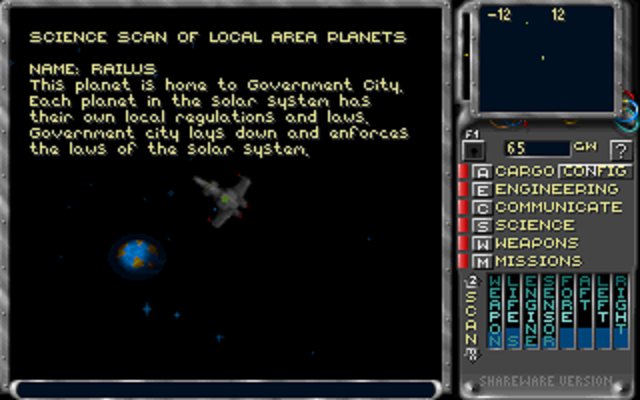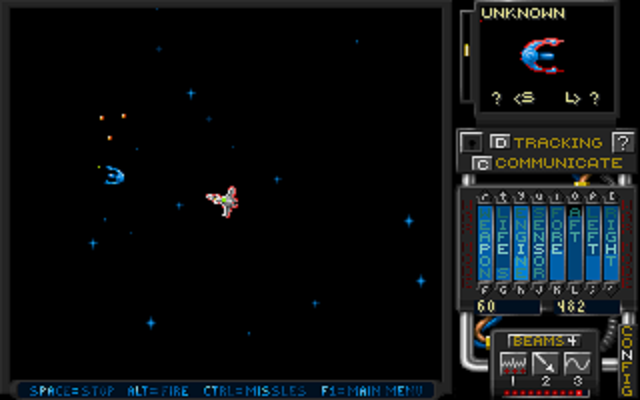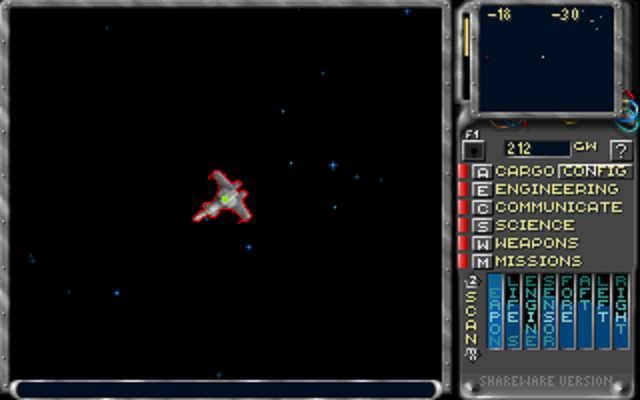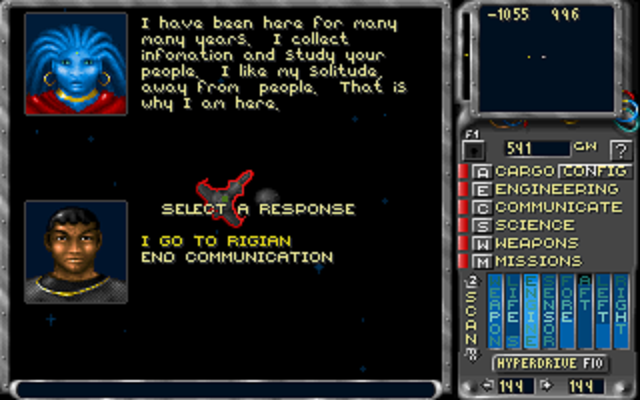Game Review: Solar Winds I: The Escape
For all the time I spent on DOS games in my youth, I don't go back and play them very often nowadays, even compared to how often I go back and play old console games that I used to like. Some of that is because many of the games I liked were, objectively, not very good. Replaying Jill of the Jungle reminded me how inferior it is to Super Mario Brothers 3, with the central conceit of changing forms seemingly like an afterthought and the save system removing all challenge except for going for the maximum score possible, but without the bragging rights of playing in an arcade.
But other games were great, and Solar Winds is one of them.

This is the first dialogue in the game.
Top-down spaceflight action RPG is not a genre that was well-represented on early consoles, not even in 1993 when Solar Winds came out, or in 1994 when I found it on one of those old shareware discs with dozens and dozens of games. I installed it based on the one-line description--probably something like "You are Jake Stone, bounty hunter. Explore three solar systems!", but unfortunately I don't remember which shareware CD I got it from--and loaded it up, and then was drawn in by the intro. Immediately after the player learns that there are humans in a star system far from Earth, Jake Stone receives a hot tip on a bounty available and then it drops you into gameplay, after which an alien ship uncloaks and hails you. Then, after proclaiming its superiority, it vanishes, leaving the player with plenty of questions and a desire to learn more about the world.
At least, that's how it worked on me. I've learned since that it's extremely easy for a more bloodthirsty player to lock themselves out of beating the game in the first few minutes, either by attacking the alien ship and being unable to win the battle (which, at the very beginning, is almost certain), or by executing the bounty as ordered. Emer Kane tells Jake Stone about a dangerous criminal who needs to be killed, but the criminal claims to be a scientist, and indeed he is. Killing the scientist locks out the entirety of the plot. I can see how people who took the game at face value would be annoyed by it and think that it was badly designed, but I never did. I listened to the scientist, and so I thought of the game as being filled with hidden secrets and conspiracies, where I should look underneath the surface everywhere I went. It's not a large game, but that sense of mystery made it feel much larger and more intricate than it actually is.

Government City, home of Government Man, from The Government.
This is reinforced after the opening mission with other characters mentioning that the rebellion against the government being more active lately, rumors that the government is clamping down on any research into hyperdrive technology with draconian force, and even one planet in the star system that seems to be the homeworld of an isolationist alien race who tell Stone that they're tired of the government badgering them for technological aid and they aren't going to listen to any further entreaties.
Or is it...that humans are the aliens here?
I'm sure I don't have to answer that. It all comes out when Jake Stone gets a prototype hyperdrive and is asked to rescue a captain who was captured by the Rigians, the aliens who showed up at the very beginning of the game. Halfway there is a planet with an alien who reveals that Stone is not the first ship sent to the Rigian system and that none of them have ever returned, and that they are put there to watch. But of course, there's no choice but to keep going despite knowing that it's all a trap.

Let battle be joined.
I said that Solar Winds was an action RPG, and while there aren't levels in the traditional sense, the game still has a version of experience. The reward for completing the first mission is an "E-Band Convertor," which through a technobabble process converts the radiation burst from starship reactor explosions into power. That means that killing enemy ships provides extra power for Stone's ship, which can then be allocated between weapons, engine, shields, life support, and four quadrants of shields. Add to this dumb fire and homing missiles and shield and weapon frequencies which can be changed on the fly to blunt the impact of enemy weapons and increase the damage of your own, and the fact that enemy attacks permanently reduce shield strength, and there's plenty of bits to collect and fiddle with over the course of the game.
Unfortunately, the frequency system feels superfluous. When I played as a child I never used it simply due to not being able to press all the buttons at the same time, and, admittedly, not really understanding how it worked. When I played now, I tried briefly to use it, and then stopped because it was too complicated for the benefit it provided. Nothing in the game actually needs it.
Despite that, energy management is a lot of fun. Sure, it's literally making numbers go up, but I like watching the long-range sensors going from detecting only planets and stars to detecting moons to detecting enemy ships, or seeing the shields go from dim red to incandescent white.

You will stare at this screen a lot.
For all that I still think the story is elegantly told, albeit with a major breaking point very early on and the depth being more feeling than reality, the gameplay feels pretty simplistic now. It's top-down, and the limitations of VGA display means that the screen is very cramped. The way around that is the screenshot above of "war mode," which the game will automatically switch to if enemy ships ever open fire. And when they do open fire, they're without exception pushovers. It's incredibly easy to get behind an enemy ship and just keep shooting until it dies. This continues even in the Rigian star system, where Jake Stone's single ship destroys entire fleets by itself and shows the words of the alien in the beginning to be dust in the face of hot plasma.
It doesn't get stale, but partially that's because the game isn't very long. While I love the idea of a longer space-action RPG game like this, with the complexity of Solar Winds refined and expanded on, that doesn't happen here. About the only threat during the entire game are multiple ships at once, and even that isn't too difficult because enemy ships don't coordinate in any meaningful fashion and have a very low player awareness. Most multi-ship battles quickly became duels when one enemy ran off and, while following him, the other enemy's AI forgot I existed and it went back to what it was doing. Solar Winds is not the game for complex strategic decisions. It's a game for pew pewing at spaceships, watching them explode, and seeing your available energy increase and then pouring that energy into your ship systems.
And sitting and watching space scroll by. A modern game would have fast travel, with energy automatically being deducted fro the appropriate distance, but this is an old DOS game so all flying is manual. It does allow the Picard Maneuver, where you active hyperdrive, blast behind an enemy ship, then turn and fire, but that's not really worth the long periods staring at interstellar space. It certainly does have a sense of scale, but at the cost of a lot of downtime flying around.

Same.
It ends on a cliffhanger, because of course it does--it's a shareware game. The whole point is to get the player hankering for volume two, subtitled "Galaxy" (or "Universe," I've seen both). I never bought it, but I did track it down years later and play it and it was extremely disappointing. It didn't have a lot of the extra color that the first episode had, and without it, the multiple star systems all just felt empty. Planets without any description don't make the world feel expansive, they make it feel padded.
But this doesn't have that problem. It's a couple hours long and obviously the intro for a larger experience, and I love what it promised rather than what ended up being delivered. I'd love to see a version of Solar Winds' RPG-like systems merged with the scope and complexity of EV Nova. Maybe it'll happen someday. But as it is, ignoring the second episode, the first episode is a fun game in itself.
A few minutes of opening gameplay are visible in this video.
But other games were great, and Solar Winds is one of them.

This is the first dialogue in the game.
Top-down spaceflight action RPG is not a genre that was well-represented on early consoles, not even in 1993 when Solar Winds came out, or in 1994 when I found it on one of those old shareware discs with dozens and dozens of games. I installed it based on the one-line description--probably something like "You are Jake Stone, bounty hunter. Explore three solar systems!", but unfortunately I don't remember which shareware CD I got it from--and loaded it up, and then was drawn in by the intro. Immediately after the player learns that there are humans in a star system far from Earth, Jake Stone receives a hot tip on a bounty available and then it drops you into gameplay, after which an alien ship uncloaks and hails you. Then, after proclaiming its superiority, it vanishes, leaving the player with plenty of questions and a desire to learn more about the world.
At least, that's how it worked on me. I've learned since that it's extremely easy for a more bloodthirsty player to lock themselves out of beating the game in the first few minutes, either by attacking the alien ship and being unable to win the battle (which, at the very beginning, is almost certain), or by executing the bounty as ordered. Emer Kane tells Jake Stone about a dangerous criminal who needs to be killed, but the criminal claims to be a scientist, and indeed he is. Killing the scientist locks out the entirety of the plot. I can see how people who took the game at face value would be annoyed by it and think that it was badly designed, but I never did. I listened to the scientist, and so I thought of the game as being filled with hidden secrets and conspiracies, where I should look underneath the surface everywhere I went. It's not a large game, but that sense of mystery made it feel much larger and more intricate than it actually is.

Government City, home of Government Man, from The Government.
This is reinforced after the opening mission with other characters mentioning that the rebellion against the government being more active lately, rumors that the government is clamping down on any research into hyperdrive technology with draconian force, and even one planet in the star system that seems to be the homeworld of an isolationist alien race who tell Stone that they're tired of the government badgering them for technological aid and they aren't going to listen to any further entreaties.
Or is it...that humans are the aliens here?

I'm sure I don't have to answer that. It all comes out when Jake Stone gets a prototype hyperdrive and is asked to rescue a captain who was captured by the Rigians, the aliens who showed up at the very beginning of the game. Halfway there is a planet with an alien who reveals that Stone is not the first ship sent to the Rigian system and that none of them have ever returned, and that they are put there to watch. But of course, there's no choice but to keep going despite knowing that it's all a trap.

Let battle be joined.
I said that Solar Winds was an action RPG, and while there aren't levels in the traditional sense, the game still has a version of experience. The reward for completing the first mission is an "E-Band Convertor," which through a technobabble process converts the radiation burst from starship reactor explosions into power. That means that killing enemy ships provides extra power for Stone's ship, which can then be allocated between weapons, engine, shields, life support, and four quadrants of shields. Add to this dumb fire and homing missiles and shield and weapon frequencies which can be changed on the fly to blunt the impact of enemy weapons and increase the damage of your own, and the fact that enemy attacks permanently reduce shield strength, and there's plenty of bits to collect and fiddle with over the course of the game.
Unfortunately, the frequency system feels superfluous. When I played as a child I never used it simply due to not being able to press all the buttons at the same time, and, admittedly, not really understanding how it worked. When I played now, I tried briefly to use it, and then stopped because it was too complicated for the benefit it provided. Nothing in the game actually needs it.
Despite that, energy management is a lot of fun. Sure, it's literally making numbers go up, but I like watching the long-range sensors going from detecting only planets and stars to detecting moons to detecting enemy ships, or seeing the shields go from dim red to incandescent white.

You will stare at this screen a lot.
For all that I still think the story is elegantly told, albeit with a major breaking point very early on and the depth being more feeling than reality, the gameplay feels pretty simplistic now. It's top-down, and the limitations of VGA display means that the screen is very cramped. The way around that is the screenshot above of "war mode," which the game will automatically switch to if enemy ships ever open fire. And when they do open fire, they're without exception pushovers. It's incredibly easy to get behind an enemy ship and just keep shooting until it dies. This continues even in the Rigian star system, where Jake Stone's single ship destroys entire fleets by itself and shows the words of the alien in the beginning to be dust in the face of hot plasma.
It doesn't get stale, but partially that's because the game isn't very long. While I love the idea of a longer space-action RPG game like this, with the complexity of Solar Winds refined and expanded on, that doesn't happen here. About the only threat during the entire game are multiple ships at once, and even that isn't too difficult because enemy ships don't coordinate in any meaningful fashion and have a very low player awareness. Most multi-ship battles quickly became duels when one enemy ran off and, while following him, the other enemy's AI forgot I existed and it went back to what it was doing. Solar Winds is not the game for complex strategic decisions. It's a game for pew pewing at spaceships, watching them explode, and seeing your available energy increase and then pouring that energy into your ship systems.
And sitting and watching space scroll by. A modern game would have fast travel, with energy automatically being deducted fro the appropriate distance, but this is an old DOS game so all flying is manual. It does allow the Picard Maneuver, where you active hyperdrive, blast behind an enemy ship, then turn and fire, but that's not really worth the long periods staring at interstellar space. It certainly does have a sense of scale, but at the cost of a lot of downtime flying around.

Same.

It ends on a cliffhanger, because of course it does--it's a shareware game. The whole point is to get the player hankering for volume two, subtitled "Galaxy" (or "Universe," I've seen both). I never bought it, but I did track it down years later and play it and it was extremely disappointing. It didn't have a lot of the extra color that the first episode had, and without it, the multiple star systems all just felt empty. Planets without any description don't make the world feel expansive, they make it feel padded.
But this doesn't have that problem. It's a couple hours long and obviously the intro for a larger experience, and I love what it promised rather than what ended up being delivered. I'd love to see a version of Solar Winds' RPG-like systems merged with the scope and complexity of EV Nova. Maybe it'll happen someday. But as it is, ignoring the second episode, the first episode is a fun game in itself.
A few minutes of opening gameplay are visible in this video.